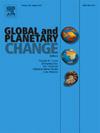评估加拉帕戈斯群岛农业景观的自然气候解决方案
IF 4
1区 地球科学
Q1 GEOGRAPHY, PHYSICAL
引用次数: 0
摘要
加拉帕戈斯群岛极易受到气候和环境变化的影响,而基于自然的解决方案可以帮助当地社区适应当地的农业系统。通过比较分析,我们评估了三种土地管理策略对圣克鲁斯岛(加拉帕戈斯群岛)土壤温度、土壤水分供应和储存以及碳储量的影响。我们设置了六个监测点,每个监测点由两个重复点组成:(i) 避免热带雨林的消失;(ii) 保护零星树木和危险农林系统中的活栅栏;(iii) 降低放牧强度后生物量的增加。监测点配备了密集的雨量计网络、空气温度和相对湿度传感器,以及记录体积含水量和土壤温度的电容/频率探头。在对土壤剖面进行土壤学特征描述后,在实验室测定了土壤的物理化学和水文物理特性。在为期 30 个月(2019 年 7 月至 2021 年 12 月)的时间里,我们收集了水文气象和土壤环境数据。我们评估了原生林、传统农林业用地和被动恢复用地之间在土壤温度、水分可用性和土壤有机碳含量方面的差异。森林土壤的温度比传统农林业地块低 12%;森林土壤的湿度比采用造林-牧业管理的地块高 20%。与其他两种管理类型相比,森林土壤的干容重较低,饱和导水率较低,保水能力较强。在植树造林系统中,放牧强度的降低对土壤碳储量有积极影响,比传统管理下的土壤碳储量高出约 50%。这项研究表明,在农业景观中避免热带雨林的损失是缓解土壤温度升高、农业干旱和土壤有机碳含量下降的有效策略。有必要对实验点进行持续监测,以便在更长的时间尺度上证实这项调查的结果。本文章由计算机程序翻译,如有差异,请以英文原文为准。
Evaluation of nature-based climate solutions for agricultural landscapes in the Galápagos Islands
The Galápagos Islands are highly vulnerable to climate and environmental change, and nature-based solutions can help local communities adapt local agricultural systems. Through a comparative analysis, we evaluated the effects of three land management strategies on soil temperature, soil water availability and storage, and carbon stocks in Santa Cruz Island (Galápagos Archipelago). We installed six monitoring sites that consisted of two replicates per pathway: (i) the avoided loss of tropical forest, (ii) the conservation of scattered trees and living fences in at-risk agroforestry system, and (iii) the increase in biomass after a reduction of the grazing intensity. The monitoring sites were equipped with a dense network of rain gauges, air temperature and relative humidity sensors, and capacitance/frequency probes that registered volumetric water content and soil temperature. After pedological characterization of the soil profiles, the soil physico-chemical and hydrophysical properties were determined in laboratory. Over a period of 30 months (July 2019 to December 2021), hydrometeorological and soil environmental data were collected.
We assessed differences in soil temperature, moisture availability and soil organic carbon content between native forests, sites under traditional agroforestry and under passive restoration. Forest soils were 12 % cooler;, and soil moisture under forest was 20 % higher than in parcels with silvopastural management. Forest soils had a lower dry bulk density, lower saturated hydraulic conductivity and higher water retention capacity in comparison with the other two management types. In silvopastural systems, a decrease of grazing intensity had a positive effect on soil carbon stocks, that were about 50 % higher than in soils under traditional management. This study shows that avoided loss of tropical forest within an agricultural landscape is a promising strategy to mitigate increasing soil temperatures, agricultural drought, and decline in soil organic carbon content. Continued monitoring of the experimental sites is necessary to corroborate the findings of this investigation at longer temporal scales.
求助全文
通过发布文献求助,成功后即可免费获取论文全文。
去求助
来源期刊

Global and Planetary Change
地学天文-地球科学综合
CiteScore
7.40
自引率
10.30%
发文量
226
审稿时长
63 days
期刊介绍:
The objective of the journal Global and Planetary Change is to provide a multi-disciplinary overview of the processes taking place in the Earth System and involved in planetary change over time. The journal focuses on records of the past and current state of the earth system, and future scenarios , and their link to global environmental change. Regional or process-oriented studies are welcome if they discuss global implications. Topics include, but are not limited to, changes in the dynamics and composition of the atmosphere, oceans and cryosphere, as well as climate change, sea level variation, observations/modelling of Earth processes from deep to (near-)surface and their coupling, global ecology, biogeography and the resilience/thresholds in ecosystems.
Key criteria for the consideration of manuscripts are (a) the relevance for the global scientific community and/or (b) the wider implications for global scale problems, preferably combined with (c) having a significance beyond a single discipline. A clear focus on key processes associated with planetary scale change is strongly encouraged.
Manuscripts can be submitted as either research contributions or as a review article. Every effort should be made towards the presentation of research outcomes in an understandable way for a broad readership.
 求助内容:
求助内容: 应助结果提醒方式:
应助结果提醒方式:


